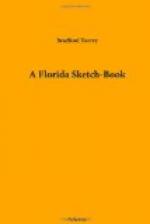That the sounds were wing-made I had no thought of questioning. I had seen the thing done,—seen it and heard it; and what shall a man trust, if not his own eyes and ears, especially when each confirms the other? Two days afterward, nevertheless, I began to doubt. I heard a grackle “sing” in the manner just described, wing-beats and all, while flying from one tree to another; and later still, in a country where boat-tailed grackles were an every-day sight near the heart of the village, I more than once saw them produce the sounds in question without any perceptible movement of the wings, and furthermore, their mandibles could be seen moving in time with the beats. So hard is it to be sure of a thing, even when you see it and hear it.
“Oh yes,” some sharp-witted reader will say, “you saw the wings flapping,—beating time,—and so you imagined that the sounds were like wing-beats.” But for once the sharp-witted reader is in the wrong. The resemblance is not imaginary. Mr. F.M. Chapman, in A List of Birds Observed at Gainesville, Florida,[1] says of the boat-tailed grackle (Quiscalus major): “A singular note of this species greatly resembles the flapping of wings, as of a coot tripping over the water; this sound was very familiar to me, but so excellent is the imitation that for a long time I attributed it to one of the numerous coots which abound in most places favored by Q. major.”
[Footnote 1: The Auk, vol. v. p. 273.]
If the sounds are not produced by the wings, the question returns, of course, why the wings are shaken just at the right instant. To that I must respond with the time-honored formula, “Not prepared.” The reader may believe, if he will, that the bird is aware of the imitative quality of the notes, and amuses itself by heightening the delusion of the looker-on. My own more commonplace conjecture is that the sounds are produced by snappings and gratings of the big mandibles ("He is gritting his teeth,” said a shrewd unornithological Yankee, whose opinion I had solicited), and that the wing movements may be nothing but involuntary accompaniments of this almost convulsive action of the beak. But perhaps the sounds are wing-made, after all.




